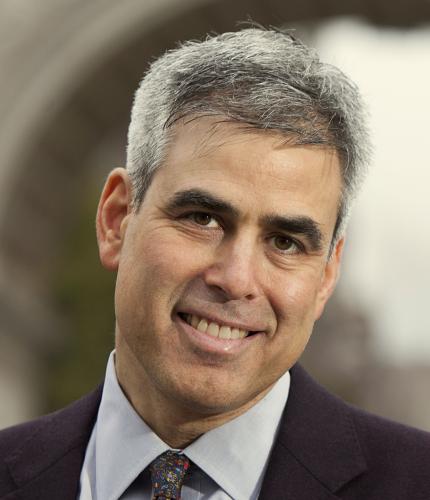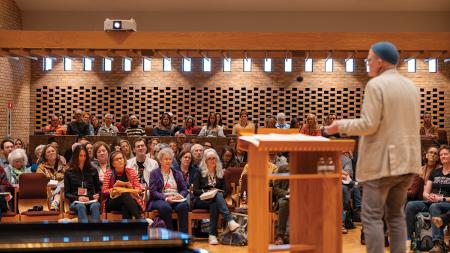Social Media Is Killing Some Kids

Calvin University
Due in large part to use of social media and overzealous parenting, high-school and college-age girls are experiencing unprecedented levels of anxiety and depression as well as self-harming and even committing suicide, said social psychologist, ethicist, and author Jonathan Haidt at the January Series 2020.
“We are pushing against a headwind. We are seeing a mental-health crisis happening nationally and internationally,” said Haidt in a talk titled “The Coddling of the American Mind: How Good Intentions and Bad Ideas Are Setting Up a Generation for Failure.”
While boys are also experiencing mental-health issues, girls are the ones who are flooding mental-health clinics at schools and in communities and showing up in emergency rooms, said Haidt, whose research focuses on the emotional foundations, cultural variations, and developmental course of ethics and morality.
Held in the Covenant Fine Arts Center at Calvin University, the January Series runs every weekday from 12:30 p.m. to 1:30 p.m. (EST) through Jan. 28. The presentations are available live at more than 60 remote webcast locations. The series is also streamed with audio only at 12:30 p.m. EST.
As recently as 2009, hospitals had very few statistics on the rate of girls deliberately cutting themselves. But that rate has gone up in recent years by 62 percent for older teens and 189 percent for younger girls, said Haidt.
Haidt points to addiction to social media, coupled with growing up with parents who are overprotective, as reasons for this spike in mental-health difficulties, especially among girls.
Before getting into the issue of parenting, Haidt discussed the consequences he has seen in his research of social media.
“Skeptics say that this isn’t happening. But the use of social media — of Facebook, MySpace, Twitter, and Instagram — is having a big impact on girls,” he said. “This isn’t as much the case with boys, since they spend much of their time playing games” on their phones and other devices and not interacting as much on social media.
When Facebook first became popular in about 2006, it was fairly benign. But things started to change in 2009 when Facebook added its “Like” button on accounts and then began to send users information particularly geared to their interests and to connect them with others they didn’t know.
“When you hit that Like button, they began to send stories that engaged or enraged you, and Facebook became much more addictive,” said Haidt, who is the Thomas Cooley Professor of Ethical Leadership at New York University’s Stern School of Business.
“What happened is that social media became an outrage machine. . . . Anything you say can cause a response, and the more outrageous things you say, the better.”
Haidt called this “an existential threat to democracy.” Many loud voices, often speaking viciously and with a vengeance, began to do battle over social media. A tool for making and keeping in touch with friends became something else altogether.
“This has been especially bad for teens. When you are communicating in this way in front of others, you become concerned as to what others think, and you get self-conscious,” he said.
“We find teens moving from relationships in real life to social media,” said Haidt. “Again, this is a problem for boys, but much more so for girls who are more affected by social comparisons and have a fear of being left out. For many girls, their prestige is central, and it is a question of who is in and who is out.”
Many boys express their aggression physically, such as in playing sports, while girls tend to become aggressive with the words they use, Haidt said.
“Social media has transformed kids’ worlds,” he added. “And the popularity of Instagram, Twitter, and MySpace have trapped us as parents to allow our kids — because they say all their friends are doing it — to stay on social media. They don’t go out and play. They don’t go over to their friends’ houses.”
Being addicted to and captured by the attraction of social media, young people live to be on their computers, tablets, and phones. Cut off from face-to-face interactions, they become lonely and even fearful, said Haidt.
For a portion of girls, he argues, this has translated into the growth of anxiety and depression and tendency for self-harm.
Adding to this — for both girls and boys — is the movement by parents over the past 20 or so years to overprotect their children, said Haidt.
By keeping their children under their wing for far too long, parents have not allowed young people to learn their own limits or to explore the world beyond the boundaries set by their parents.
“If a parent is always there to protect their child and to make up for their mistakes, they don’t learn to take care of themselves,” he said.
If your child forgets his lunch and you rush to school to make sure he has it, he doesn’t learn to be responsible and take his lunch along to school with him next time.
Perhaps out of fear that the world is a dangerous place, parents keep their children at home, where they often turn to social media to keep them occupied.
“We have been depriving a generation of free play. We set the rules and try to solve conflicts for them,” Haidt said. “Free play teaches you to make your own choices about risk. Eliminating all risk may be dangerous.”
Besides asking parents to back off and offer a little more trust to their children, Haidt offered some suggestions on how to handle social media:
“Ban all devices during school. Don’t allow them in backpacks. Lock them away,” he said.
At home, make a firm rule that all screens are out of the bedroom by a certain time every day. Also, he said, do what he does with his children. “No social media until high school.”
Work with your children on a budget of time, listing when and for how long they can use their devices. If you do this, you’ll be surprised, he added.
“Young people are addicted, and they know it,” said Haidt. Actually, if you are serious about it and consistent, your child will likely respond favorably. They already know what part of using their devices is good and what is bad.”
Haidt is the codeveloper of Moral Foundations Theory, and of the research site YourMorals.org. He uses his research to help people understand and respect the moral motives of people with whom they disagree (see CivilPolitics.org). He is also the codeveloper of OpenMindPlatform.org, an educational program that teaches people and groups how to have productive conversations across many lines of difference.
He is also the author of more than 90 academic articles and three books, the most recent being The Coddling of the American Mind: How Good Intentions and Bad Ideas Are Setting Up a Generation for Failure (2018, coauthored with Greg Lukianoff).


